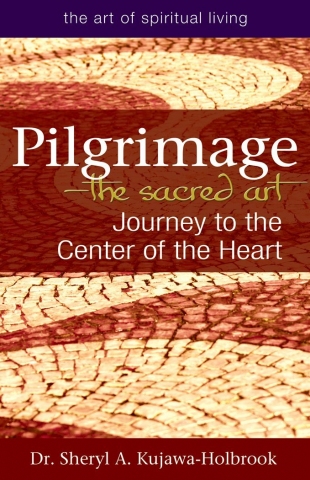Dr. Sheryl A. Kujawa-Holbrook is an Episcopal priest and popular speaker on the topics of spiritual formation, ministry development, and religious education. She is professor of practical theology and religious education at Claremont School of Theology, and professor of Anglicanism at Bloy House, the Episcopal Theological School at Claremont. Kujawa-Holbrook is the author of two books. This volume on Pilgrimage is part of Skylight Paths' series "The Art of Spiritual Living."
The practice of pilgrimage cuts across all cultures and is part of nearly every religion. What does this journey entail? Kujawa-Holbrook defines it as "a life-changing journey" that can be a search for meaning, peace, or freedom. It can grow out of a devotional visit to a holy place, a shrine, or the site of a significant event in the pilgrim's life. With precision and care, the author describes pilgrimage in the following traditions: Hindu, Buddhist, Greek and Roman, and Abrahamic. Kujawa-Holbrook does a fine job describing the out-of-the-box pilgrimages that are secular or occur via cyberspace.
In a chapter on "The Way of the Heart," the author probes the spiritual nourishment of pilgrim narratives such as Landscapes in the Sacred by Belden C. Lane; The Alchemist by Paulo Coelho; Eat, Pray, Love by Elizabeth Gilbert; and Traveling with Pomegranates: A Mother-Daughter Story by Sue Monk Kidd and her daughter Ann. She then moves on to examine Carl Jung, the stages of pilgrimage, and the connections between the inward journey and the way of the heart.
Holy places and sacred places provide pilgrims with a wide variety of experiences in Kujawa-Holbrook's eclectic treatment of the quest for the Holy Grail, the Celtic sacred landscape, the Holocaust Memorial Museum, the Ganges river in India, the isle of Iona, Mount Athos in Greece, the Taize community in France, and the concentration camps of Auschwitz and Birkenau. In the last three chapters, the author hits high stride with coverage of the labyrinth as a pilgrim's path and a journey to the center of the heart; in her assessments of the journey home where the task is to draw out all the connections between pilgrimage and home; and in her celebration of pilgrimage as "feet-on-the-ground spirituality" — a term coined by Jan Sutch Pickard of the Iona community. In the concluding chapter, the engaged reader will find plenty of life-affirming practices that can punctuate all aspects of the spiritual journey. Kujawa-Holbrook's Pilgrimage is a top-drawer, eclectic, and creative meditation on this sacred art.
